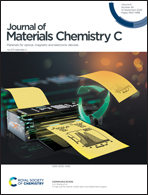A biocompatible cellulose-nanofiber-based multifunctional material for Fe3+ detection and drug delivery†
Abstract
Although biomass-based materials offer several advantages as matrices for the development of multifunctional sensors, they have rarely been applied for dual-function solid colorimetric and spectrophotometric sensing. Herein, a nanoscale cellulose-nanofiber-based multifunctional material (CNF-DA) with excellent biocompatibility was prepared by grafting dopamine (DA) onto cellulose nanofibers with carboxyl groups (CNF-COOH) using an amidation reaction. Owing to the morphological diversity of as-prepared CNF-DA (e.g., a nanoscale homogeneous suspension, solid nanofibers, and an aerogel), multifunctional properties, including drug delivery, antibacterial properties, and spectrophotometric and solid colorimetric Fe3+ sensing, were realized. Solid CNF-DA exhibited excellent selectivity and sensitivity toward Fe3+ with a remarkable color change from off-white to dark green and a limit of detection (LOD) of 5 × 10−7 mol L−1. Furthermore, CNF-DA was applied as a UV spectrophotometric sensor for Fe3+ in aqueous solution with an LOD of 6.6 × 10−11 mol L−1. CNF-DA also exhibited drug delivery and antibacterial properties owing to an abundance of hydroxyl groups and the high porosity of the nanofiber. The maximum drug loading capacity of CNF-DA and the release rate of doxorubicin were 879.09 mg g−1 and 80% at pH 1.2, respectively. Thus, multifunctional CNF-DA has broad application prospects in the areas of food science and biological medicine.



 Please wait while we load your content...
Please wait while we load your content...